 Internal Communications Webinar
Internal Communications Webinar
Do you want to improve communication and employee engagement in your organization? Don’t miss our upcoming webinar that will give you the knowledge to do this.
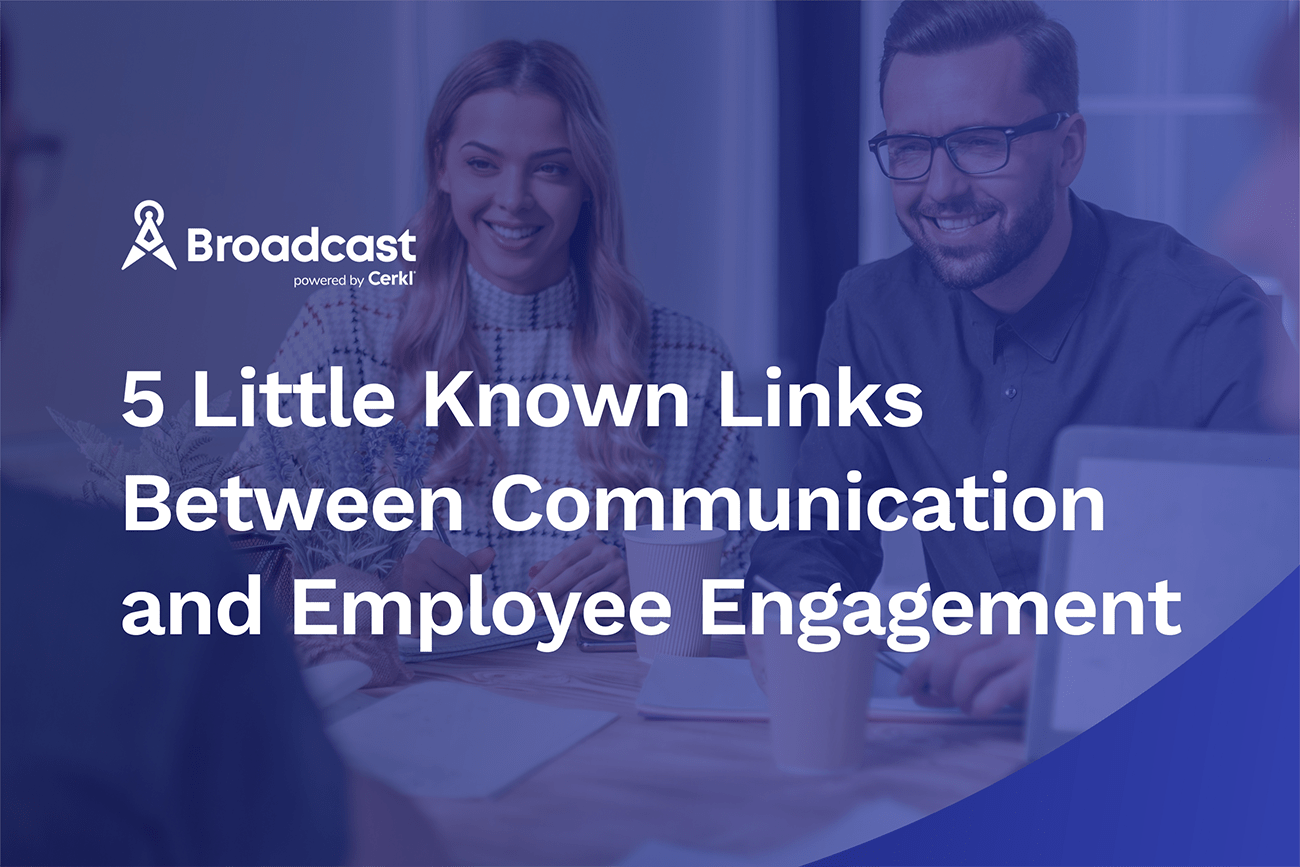
.webp)
Effective internal communication is the backbone of every successful organization. Learn the ins and outs of internal communications with our research-backed white paper.
Access NowThe quality of employer-employee communication significantly impacts employee engagement. Intuitive communication can help foster a work environment that motivates employees, builds trust, and drives engagement. A lack of solid internal communications can have completely the opposite effect … with disastrous consequences.
According to the Harris Poll and Grammarly Business 2023 The State of Business Communication, the majority of business leaders and knowledge workers believe that effective communication is “key to business performance.” It enhances productivity, improves collaboration, and powers up work experiences.
When companies invest in internal communications to improve employee engagement, they instill confidence, responsiveness, and efficiency into daily work. Proficient communication transforms mere interactions into meaningful relationships and converts abstract business strategies into shared motivation. Conversely, inadequate communication acts as a barrier to performance, often leading to the breakdown of essential company functions when the communication infrastructure falters.

“But with intentional investment, you can turn workplace communication from a liability to your strongest advantage.”
The State of Business Communication
The question is, what are the links between communication and employee engagement? We’re going to look at these and highlight the principles of employee engagement and internal communications. Then we’ll explore how they are inter-related and what strategies we can use to strengthen and improve both in the workplace.
In any organization, clear communication and employee engagement are critical for shaping successful business operations. Not only do they foster better interpersonal relationships between team members but they also optimize performance metrics.
Let's look at what these two concepts mean and how they differ from each other.
Employee communication, often referred to as internal communications, is the process through which information flows within an organization, from frontline workers to high-level management and vice versa. Effective communication includes a range of important elements including:
Employee engagement refers to the emotional commitment an employee has toward their organization and its goals. This commitment goes beyond job satisfaction and is not simply about employee happiness. An engaged employee is deeply involved in, enthusiastic about, and genuinely cares about their work. Here are a few key components of employee engagement:
According to Gallup’s State of the Global Workplace 2023 Report, when combined with actively disengaged employees, low engagement costs the global economy 8.8 trillion dollars, or 9% of global GDP. So, it isn’t rocket science that it pays to increase employee engagement and get as many as possible actively engaged.
Turn your internal communications strategy around today

There is no mistaking the correlation between effective communication and employee engagement. Improving employee engagement through effective internal communications is not just a trendy topic in personnel management. It's become a vital necessity for successful business operations. It encourages a culture of transparency, promotes a sense of belonging among employees, and significantly impacts job satisfaction.
But according to the 2023 Edelman Trust Barometer Special Report: Trust at Work, there is a notable gap in trust and alignment between employers and employees. While 77% of employees trust their employer, only 62% feel that their organization is adequately addressing their concerns. This disparity highlights the need for improved communication strategies to bridge the gap and enhance employee engagement.
In many ways, the heart of successful communication engagement strategies is understanding and leveraging the connections. Here are five fundamental relationships between communication and employee engagement that can make significant differences in job satisfaction and productivity.
Let’s focus on five key relationships that matter and will help to improve internal communications.
Trust pervades every aspect of the workplace and it’s the cornerstone for the right kind of employee engagement. Furthermore, one of the most effective ways to build trust is through ongoing, open, and inclusive dialogues.
From team meetings to one-on-one conversations with leaders, employees feel valued when they are included in these dialogues. Having transparent communication where information is freely shared builds a sense of trust and aids in setting up a high-level communication channel within the team structure.
The practice of active listening in these dialogues can also lead to a deeper understanding and respect between team members, further improving engagement. Employees who feel heard are more likely to be engaged and satisfied in the workplace.
Recognition is a powerful tool for increasing employee engagement. When employees feel appreciated because of their efforts, they are more likely to feel connected to the company and motivated to continue contributing positively to its success.
Quantum Workplace and BambooHR collaborated in research that focuses on employee recognition. A particularly telling statistic is that 52.5% of respondents want to receive more recognition from their immediate manager or supervisor. Their report, Recognition in the Workplace: Breakthrough Secret & Stats also highlights that 41% of employees want more recognition from their immediate coworkers.
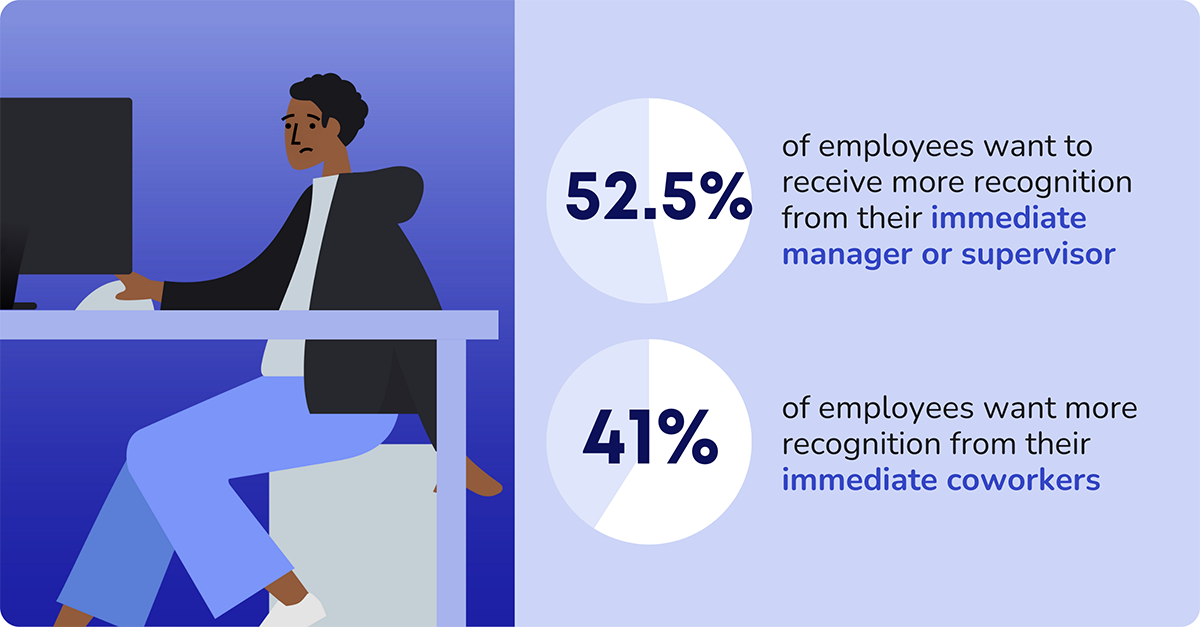
In the context of effective communication, recognition should be regular, specific, and genuine. Utilizing communication tools like acknowledgment emails, custom email lists, and friendly reminder emails can make sure praises get to everyone.
Setting up an effective employee recognition program and using your internal communications program to highlight successes can also be beneficial. Remember, it's not just about grand gestures — sometimes a simple thank you can go a long way.
Feedback is crucial in the workplace. Both giving and receiving feedback provide growth opportunities, but creating a loop where employee feedback is collected, evaluated, and acted upon is where the magic happens. Inclusive feedback loops are a sign of healthy company culture and a secure communication and employee engagement link.
Employee surveys are a common tool organizations can use to collect feedback. To make this more effective, employers should act on the feedback received. This process, often termed 'closing the feedback loop', signals to employees that their opinions and ideas are valued, leading to improved engagement.
A valuable tip is to use an employee lifecycle survey that sets the feedback process within different stages of the employment cycle. It will provide specific insights to improve employee engagement at every level. You may be super-surprised at the results.
Emotion is an under-considered factor in business that is crucial for maintaining an engaged workforce. Empathetic connections can nurture better relationships and, ultimately, better efficiency and productivity.
When it comes to internal communications, empathy plays a significant role. It's how leaders and peers can understand and respond appropriately to the feelings and needs of their team members. Empathy opens up a new level of understanding and can lead to effective and meaningful conversations that can boost engagement phenomenally.
Remember that empathetic listening is a two-way street. It involves not only understanding the feelings of others but also expressing your sympathy through your reactions, words, and actions.
Every company has (or should have) a vision or a set of goals or mission it is striving toward. Aligning communication messaging with this vision can significantly improve employee engagement.
Communicating the company's vision helps employees understand their role in the long-term success of the organization. When employees are part of the bigger picture, they are more likely to engage better with their responsibilities.
To ensure the success of vision alignment messaging, consistency is key. Leaders need to be clear and direct and relay the messages repeatedly to all employees, including frontline workers. The use of various communication tools like meetings, email communications, and visual presentations can make the delivery more effective.
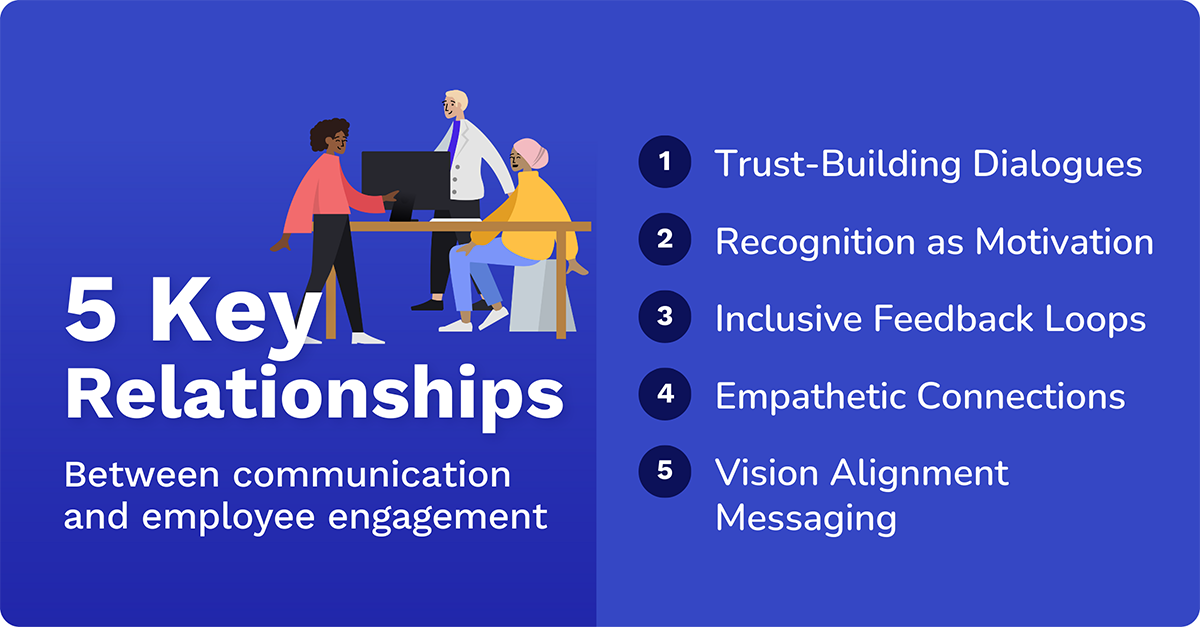
For a business to thrive, ensuring high employee engagement is a crucial component. Gallup’s ongoing engagement surveys show that fostering a high level of employee engagement can lead to increased productivity, better job satisfaction, and a more cohesive team structure. This is where communication comes into play very strongly. Effective communication is a crucial vehicle for improving employee engagement. Here are some key communication engagement strategies that you can implement:
Facilitating regular town hall meetings is a great tactic to enhance transparent communication. It provides a platform for all team members to engage, voice their thoughts, and hear about company-wide initiatives straight from the leadership.
Not only do these meetings ensure that every employee, from frontline workers to high-level executives, feels connected and informed, but they also foster a sense of belonging and ownership. When employees feel valued and heard, their engagement levels increase. With technological advancements, such meetings can easily be held in hybrid or remote work environments too.
A friendly reminder email, utilizing an email template builder, can help organize these meetings effectively. These should highlight the meeting's purpose, and main talking points, and set the tone for a positive, engaging experience.
https://vimeo.com/766663986
Digital technology offers various communication tools to foster effective internal communications. Interactive intranet platforms ensure a steady stream of communication within the team, breaking down silos, and promoting collaboration.
Intranet platforms are not only used for daily interactions but also for sharing achievements, giving shout-outs, and enabling recognition within the team. They make information easily accessible to everyone, fostering a sense of inclusion and engagement.
Additionally, they also offer tools for measuring performance metrics, providing constructive feedback, and promoting active listening. These are, of course, all key elements in boosting employee engagement.
Turn your internal communications strategy around today

To improve employee engagement, leadership should have a clear understanding of the existing internal communications landscape. One effective way to gather insights is through employee surveys.
These surveys, also known as employee lifecycle surveys or employee engagement surveys, provide employees with a platform to share their thoughts, perceptions, and suggestions about their working experience. They can be a powerful tool for gauging job satisfaction rates, work-life balance, and issues that may give rise to a bad company culture.
Surveys should be easy to complete, anonymous, and yield data that can be used for taking action. It's important to share the survey results with employees and demonstrate commitment to implement meaningful changes based on their feedback.
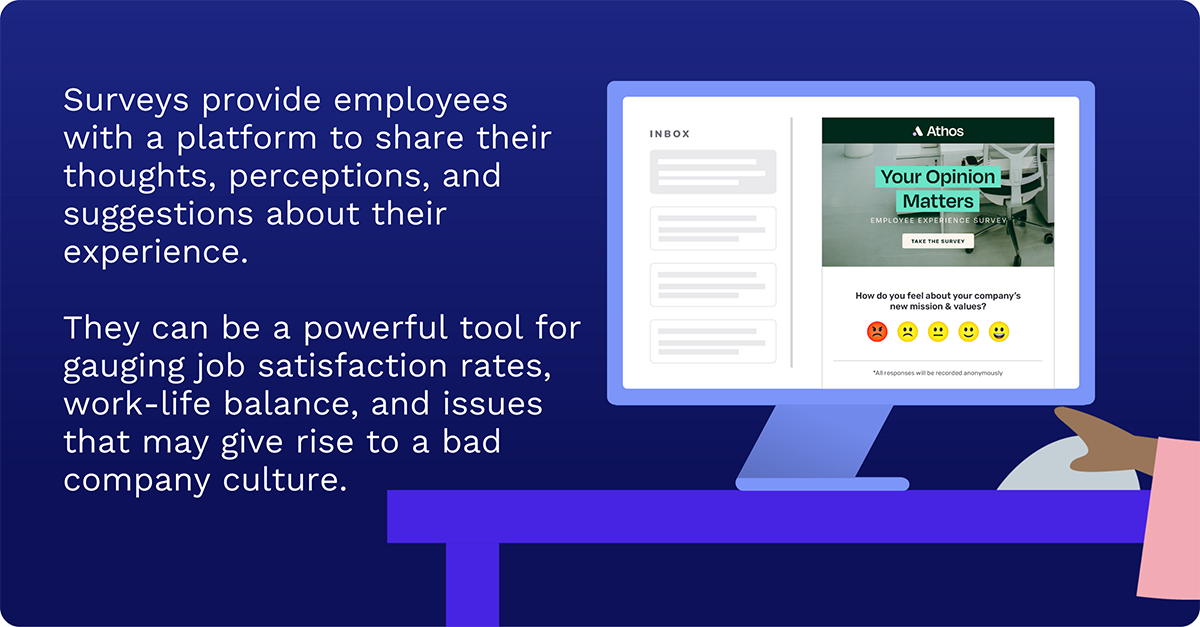
Leadership plays a pivotal role in determining how connected and engaged employees feel. Therefore, equipping leaders with effective internal communications skills is essential.
Leaders should be able to communicate with empathy, acknowledging the team members' feelings and perspectives. They should be skilled in giving and receiving feedback and promoting transparency.
Communication training for leaders can include role-playing exercises, seminars, workshops, or even one-to-one coaching sessions. These training sessions can instill good communication habits and effectively increase employee engagement.
An engaged workforce is one where employees feel connected to the organization's vision and goals. This is possible by making your internal communication more human, and storytelling does exactly that.
Organizational stories, whether they are about the company's history, employee success stories, or how challenges were overcome, can instigate emotions and foster a sense of connection. When employees can relate to a story, they’re more likely to feel motivated and engaged.
Sharing compelling stories at town hall meetings, through employee newsletters, internal influencers, or via the intranet are excellent ways of achieving this.
Employee recognition is a key factor in employee engagement. When employees feel appreciated and valued for the work they do, they are more likely to stay engaged.
Recognition programs can take various forms. From Employee of the Month awards to celebrating work anniversaries, or even commendations for a successful project, there are numerous ways to show appreciation.
Having clear goals linked to recognition programs and incorporating peer recognition are useful tactics in driving employee engagement.
Effective internal communications to improve employee engagement doesn’t have to be complicated. Simplicity is key. Clear and concise messaging ensures that important information is well understood by all employees, regardless of their role or level within the organization.
Complex jargon can cause confusion and disengagement. Therefore, plain language and clear explanations should be a priority.
This internal communications strategy is particularly important when it comes to sharing organizational goals, performance expectations, and feedback.
You’re reading this because you realize how critical internal communications are to the success of your organization. We’ve got you covered and giving you the opportunity to download our FREE Importance of Internal Communication White Paper.
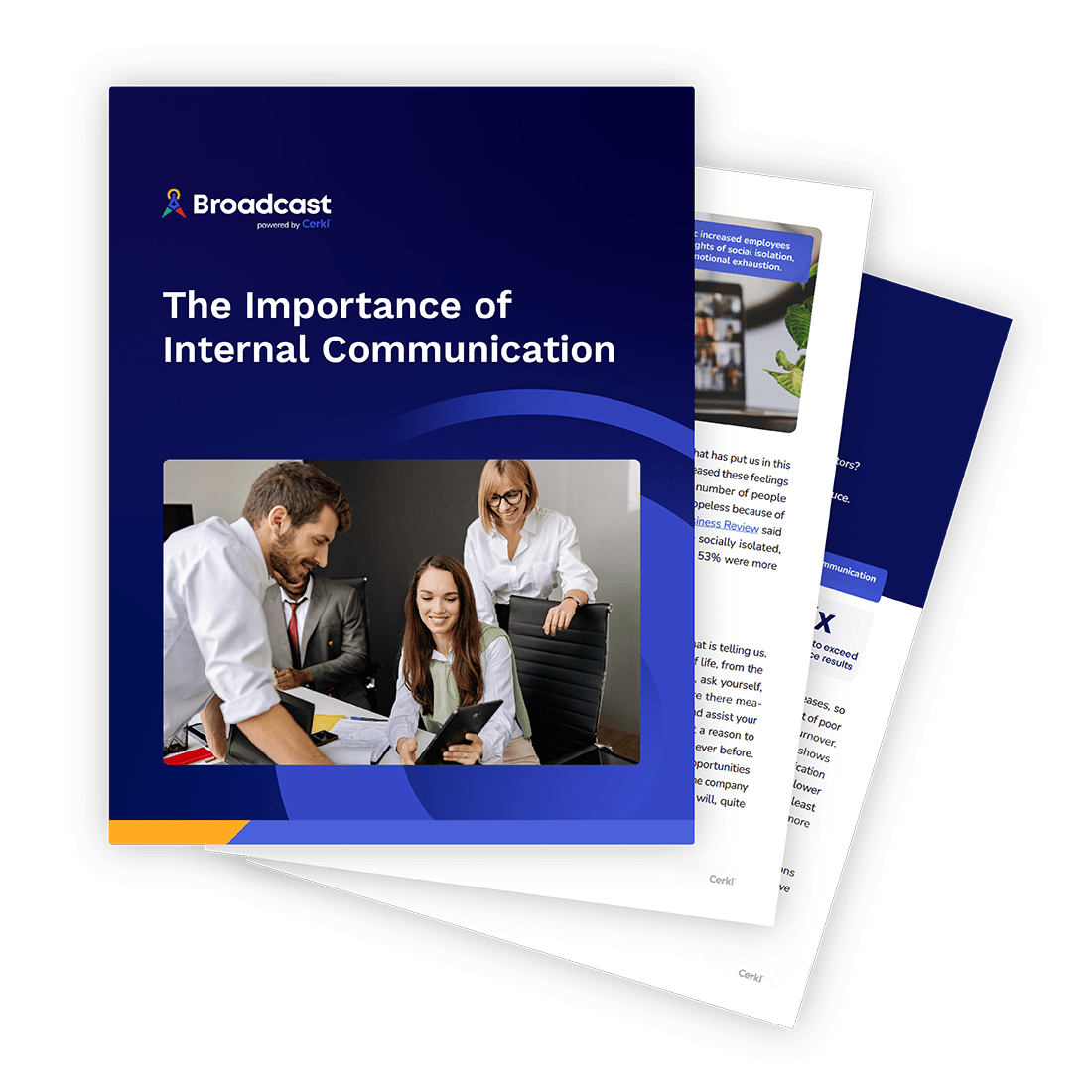
Turn your internal communications strategy around today
What is employee communication? Employee communication embodies the exchange of information between employers and employees within an organization. It commonly encompasses messages that are related to company policies, goals, and other relevant topics.
Why is communication important in employee engagement? Communication is crucial in this context as it fosters transparency and builds trust. Importantly, it ensures that employees feel informed and connected to the organization's mission and values, ultimately leading to higher levels of job satisfaction and commitment.
What is the relationship between communication and engagement? The relationship between communication and engagement is symbiotic. When communication is effective, it fuels engagement by keeping employees well-informed. Engaged employees are more likely to actively participate in communication processes and contribute positively to the workplace.
What is the role of communications and engagement? The role of communications in engagement is to facilitate open, two-way dialogues that empower employees. It does this by creating a sense of belonging and aligning individual and organizational objectives. Ultimately, it enhances overall job satisfaction and commitment.
What are the three Cs of employee engagement? The three Cs of employee engagement are usually said to be:
connection - a feeling a sense of belonging and attachment to the organization
commitment - loyalty and dedication to the organization's goals
communication - open and transparent information exchange fostering a positive work environment

Turn your internal communications strategy around today